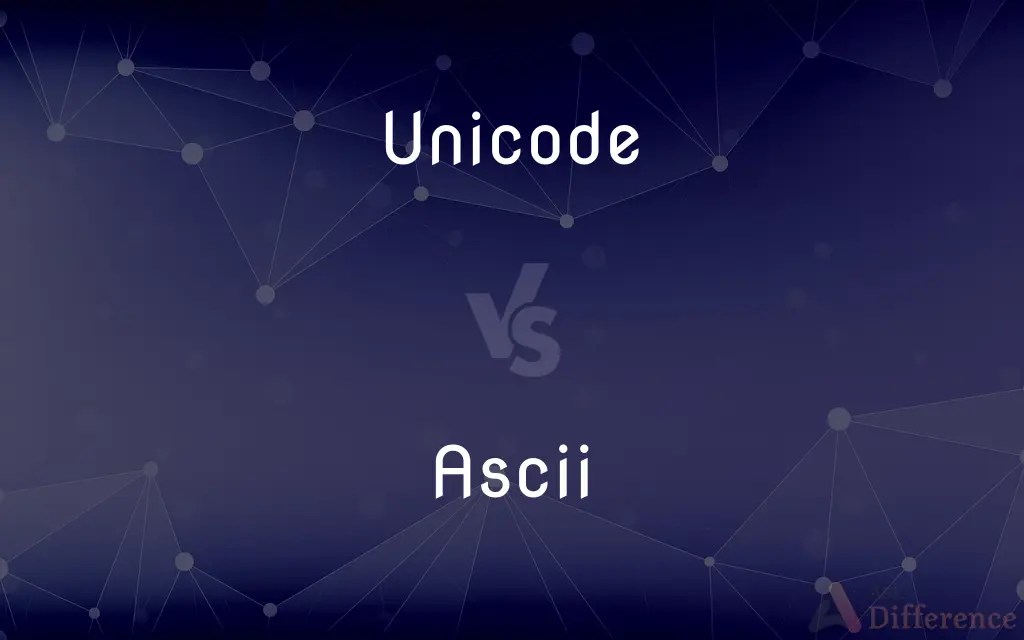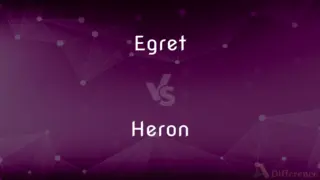Unicode vs. Ascii — What's the Difference?
By Tayyaba Rehman — Updated on September 22, 2023
Unicode is a character encoding standard that supports a wide range of characters and symbols from various languages. ASCII (American Standard Code for Information Interchange) is an older standard that covers a limited set of characters.

Difference Between Unicode and Ascii
Table of Contents
ADVERTISEMENT
Key Differences
Unicode and ASCII are both character encoding standards, but they serve different purposes and capacities. Unicode aims to cover a broad spectrum of characters and symbols, including those from various languages, mathematical symbols, and emojis. ASCII, on the other hand, was originally designed to encode 128 specific character symbols, including English alphabets, digits, and a few control characters.
Unicode's most significant advantage over ASCII is its capacity to represent a wide array of characters from multiple languages. This makes Unicode a more versatile and inclusive system, especially for international and multilingual applications. ASCII is simple and was sufficient for early computer systems that largely dealt with English text but is now considered limited.
From a technical standpoint, ASCII uses 7 bits to represent each character, which gives it a limited range of 128 possible characters. Unicode can use different bit configurations, such as UTF-8, UTF-16, and UTF-32, allowing for a more extensive set of characters. Therefore, Unicode is a superset of ASCII; the first 128 Unicode points represent the same characters as ASCII.
When it comes to compatibility, ASCII encoded text is generally smaller in size, and the format is universally recognized, making it faster and easier to process. Unicode, although more comprehensive, can be more complex to handle and may result in larger file sizes depending on the encoding used. Both encoding standards are essential, with Unicode increasingly taking precedence in modern computing environments due to its broader scope.
Comparison Chart
Character Range
Wide (includes international characters)
Limited (English alphabets, some symbols)
ADVERTISEMENT
Bit Configuration
Varies (UTF-8, UTF-16, UTF-32)
Fixed (7-bit)
Complexity
More complex
Simpler
File Size
Varies (usually larger)
Smaller
Inclusivity
Supports multiple languages and symbols
Primarily for English
Compare with Definitions
Unicode
Unicode can have varying bit configurations.
UTF-8 and UTF-16 are both Unicode encodings.
Ascii
ASCII is a 7-bit character encoding standard.
ASCII can represent a total of 128 different characters.
Unicode
Unicode is a character encoding standard.
Unicode supports a broad range of characters from various languages.
Ascii
ASCII files are smaller and faster to process.
ASCII text files are generally more lightweight.
Unicode
Unicode is a superset of ASCII.
Unicode includes all ASCII characters within its first 128 code points.
Ascii
ASCII is limited to English alphabets and symbols.
ASCII was designed primarily for the English language.
Unicode
Unicode supports international characters.
Unicode enables the encoding of characters from languages worldwide.
Ascii
ASCII is simpler than Unicode.
ASCII encoding is straightforward and easy to handle.
Unicode
Unicode is more complex than ASCII.
Handling Unicode may require additional computing resources.
Ascii
ASCII is a subset of Unicode.
The first 128 Unicode points correspond to ASCII characters.
Unicode
Unicode is an information technology standard for the consistent encoding, representation, and handling of text expressed in most of the world's writing systems. The standard, which is maintained by the Unicode Consortium, defines 143,859 characters covering 154 modern and historic scripts, as well as symbols, emoji, and non-visual control and formatting codes.
Ascii
A standard for assigning numerical values to the set of letters in the Roman alphabet and typographic characters.
Unicode
A character encoding standard for computer storage and transmission of the letters, characters, and symbols of most languages and writing systems.
Ascii
Persons who, at certain times of the year, have no shadow at noon; - applied to the inhabitants of the torrid zone, who have, twice a year, a vertical sun.
Ascii
The American Standard Code for Information Interchange, a code consisting of a set of 128 7-bit combinations used in digital computers internally, for display purposes, and for exchanging data between computers. It is very widely used, but because of the limited number of characters encoded must be supplemented or replaced by other codes for encoding special symbols or words in languages other than English. Also used attributively; - as, an ASCII file.
Ascii
(computer science) a code for information exchange between computers made by different companies; a string of 7 binary digits represents each character; used in most microcomputers
Common Curiosities
What is ASCII?
ASCII is a 7-bit character encoding standard mainly covering English alphabets and some symbols.
How many characters can ASCII support?
ASCII supports 128 different characters.
Is Unicode a superset of ASCII?
Yes, Unicode includes all ASCII characters in its first 128 code points.
Is ASCII a subset of Unicode?
Yes, the first 128 Unicode points correspond to ASCII characters.
Can Unicode handle multiple languages?
Yes, Unicode can encode characters from multiple languages.
What is Unicode?
Unicode is a character encoding standard that supports a wide range of characters and symbols.
How many characters can Unicode support?
Unicode can theoretically support over a million characters.
Which is more complex: Unicode or ASCII?
Unicode is generally more complex than ASCII.
Is ASCII suitable for multiple languages?
No, ASCII is limited mainly to the English language.
What are the different Unicode encodings?
Unicode has various encodings like UTF-8, UTF-16, and UTF-32.
Which produces larger files: Unicode or ASCII?
Unicode usually produces larger files, depending on the encoding used.
Can I convert between Unicode and ASCII?
Yes, but only if the Unicode text contains characters that have corresponding ASCII values.
How many bits does ASCII use?
ASCII uses 7 bits for each character.
Is Unicode replacing ASCII?
Unicode is increasingly preferred over ASCII for its broader range, but both coexist.
Is ASCII still in use?
Yes, ASCII is still used, especially in legacy systems.
Share Your Discovery

Previous Comparison
Egret vs. Heron
Next Comparison
Toxic vs. PoisonousAuthor Spotlight
Written by
Tayyaba RehmanTayyaba Rehman is a distinguished writer, currently serving as a primary contributor to askdifference.com. As a researcher in semantics and etymology, Tayyaba's passion for the complexity of languages and their distinctions has found a perfect home on the platform. Tayyaba delves into the intricacies of language, distinguishing between commonly confused words and phrases, thereby providing clarity for readers worldwide.














































